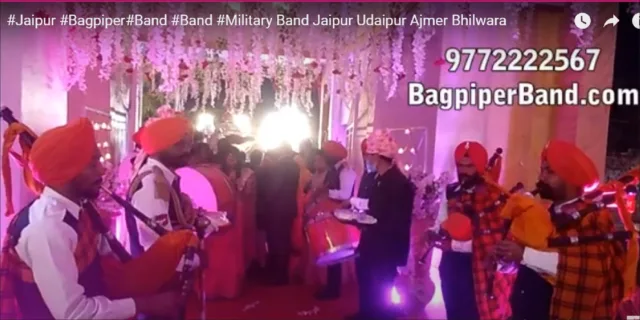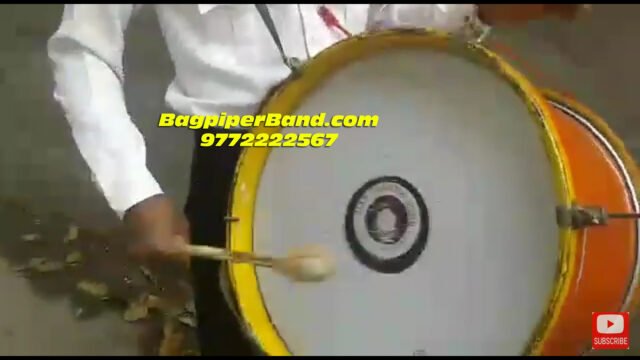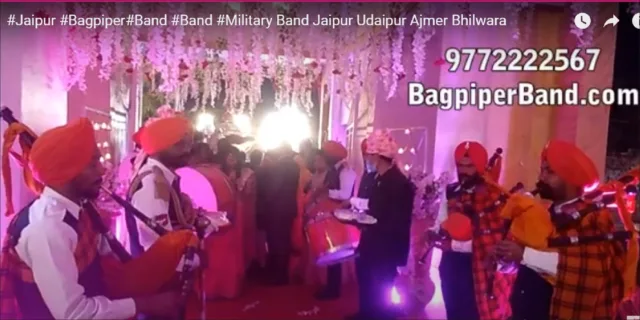Elevate Your Event with a Thrilling Hire Bagpiper Military Army Band for Ajmer, Alwar, Banswara & Baran!
Bring the stirring melodies of the pipes to your next event in Ajmer, Alwar, Banswara, or Baran! Hiring a military bagpiper band adds a powerful and unforgettable touch to any occasion. Whether you’re planning a wedding, a corporate function, a military ceremony, or a private party, these skilled musicians will leave a lasting impression on your guests.
A Touch of History and Tradition: Why Hire a Military Bagpiper Band?
Military bagpipe bands have a rich history dating back centuries. Their stirring music has been used to raise morale on the battlefield, commemorate fallen heroes, and celebrate victories. Today, these bands continue to be a source of pride for the military and a popular choice for events of all kinds.
Here are just a few reasons to hire a military bagpiper band for your next event:
Create a Unique and Memorable Atmosphere:
The powerful sound of the bagpipes is guaranteed to turn heads and create a truly special ambiance.
Add a Touch of Class and Elegance:
Military bagpipers are highly trained musicians who perform with precision and style.
Show Your Patriotism:
If you’re hosting a military-themed event, or simply want to show your respect for veterans, hiring a military bagpiper band is a great way to do so.
Versatility for any Event:
Military bagpipe bands can perform a wide range of music, from traditional Scottish tunes to popular contemporary hits.
Hiring a Bagpiper Military Army Band in Ajmer, Alwar, Banswara & Baran: What to Consider
When hiring a military bagpiper band for your event in Ajmer, Alwar, Banswara, or Baran, there are a few things to keep in mind:
The size of the band: Military bagpipe bands can range in size from a few pipers to a full ensemble. Consider the size of your venue and the overall scale of your event when making your decision.
The type of music: Be sure to ask the band about their repertoire and choose a group that performs the type of music you’re looking for.
Experience: Look for a band with experience performing at events similar to yours.
Cost: Military bagpipe bands typically charge by the hour. Get quotes from several bands before making a decision.
Here are some tips for finding a military bagpiper band in Ajmer, Alwar, Banswara, or Baran:
Search online: A quick web search will reveal several military bagpipe bands that serve these areas.
Ask for recommendations: Talk to friends, family, and event planners who may have hired a military bagpipe band in the past.
Contact us: We have their own bagpipe bands that are available for hire for public events.

Make Your Event Unforgettable with a Rousing Hire Bagpiper Military Army Band!
By hiring a military bagpiper band for your event in Ajmer, Alwar, Banswara, or Baran, you’re guaranteed to create a truly memorable experience for your guests. The powerful and evocative music of the bagpipes will add a touch of history, tradition, and excitement to your event.
So start planning your event today, and don’t forget to add the unforgettable sound of a military bagpiper band to the mix!
Elevate Your Event with a Thrilling Hire Bagpiper Military Army Band for Ajmer, Alwar, Banswara & Baran!
Bring the stirring melodies of the pipes to your next event in Ajmer, Alwar, Banswara, or Baran! Hiring a military bagpiper band adds a powerful and unforgettable touch to any occasion. Whether you’re planning a wedding, a corporate function, a military ceremony, or a private party, these skilled musicians will leave a lasting impression on your guests.
A Touch of History and Tradition: Why Hire a Military Bagpiper Band?
Military bagpipe bands have a rich history dating back centuries. Their stirring music has been used to raise morale on the battlefield, commemorate fallen heroes, and celebrate victories. Today, these bands continue to be a source of pride for the military and a popular choice for events of all kinds.
Here are just a few reasons to hire a military bagpiper band for your next event:
Create a Unique and Memorable Atmosphere: The powerful sound of the bagpipes is guaranteed to turn heads and create a truly special ambiance. When people search for “unique event entertainment ideas,” a military bagpiper band is a perfect answer.
Add a Touch of Class and Elegance: Military bagpipers are highly trained musicians who perform with precision and style. They elevate the formality of your event, making it ideal for those searching for “sophisticated event entertainment.
Show Your Patriotism: If you’re hosting a military-themed event, or simply want to show your respect for veterans, hiring a military bagpiper band is a great way to do so. This caters to users looking for “patriotic event ideas.
Versatility for any Event: Military bagpipe bands can perform a wide range of music, from traditional Scottish tunes to popular contemporary hits. This answers the user intent behind “bagpipe band for wedding ceremony.
Hiring a Bagpiper Military Army Band in Ajmer, Alwar, Banswara & Baran: What to Consider
When hiring a military bagpiper band for your event in Ajmer, Alwar, Banswara, or Baran, there are a few things to keep in mind:
The size of the band: Military bagpipe bands can range in size from a few pipers to afull ensemble. Consider the size of your venue and the overall scale of your event when making your decision.
The type of music: Be sure to ask the band about their repertoire and choose a group that performs the type of music you’re looking for. Some people might be specifically looking for “military bagpipe music for hire” or “traditional Scottish bagpipe band.
Experience: Look for a band with experience performing at events similar to yours. Users might search for “experienced bagpipe band near me” or “hire bagpipe band for wedding with experience.”
Cost: Military bagpipe bands typically charge by the hour. Get quotes from several bands before making a decision. This caters to the user searching for “cost to hire military bagpipe band.
Here are some tips for finding a military bagpiper band in Ajmer, Alwar, Banswara, or Baran:
Search online: A quick web search with terms like “hire military bagpipe band Ajmer” or “military bagpipe band for events Baran” will reveal several bands that serve these areas.
Ask for recommendations: Talk to friends, family, and event planners who may have hired a military bagpipe band in the past. This works well for users searching for “recommendations for bagpipe band near Alwar.
Make Your Event Unforgettable with a Rousing Hire Bagpiper Military Army Band!
By hiring a military bagpiper band for your event in Ajmer, Alwar, Banswara, or Baran, you’re guaranteed to create a truly memorable experience for your guests. The powerful and evocative music of the bagpipes will add a touch of history, tradition, and excitement to your event.
So start planning your event today, and don’t forget to add the unforgettable sound of a military bagpiper band to the mix!
Additionally, here are some frequently asked questions (FAQs) to consider including to further enrich the content for users:
How much does it cost to hire a military bagpiper band?
Hire Bagpiper Military Army Band for Ajmer Alwar Banswara Baran
Tags: Famous Army Band For Ajmer Alwar Banswara Baran , Military Band for Wedding Ajmer Alwar Banswara Baran , Famous Army Band For Hire Ajmer Alwar Banswara Baran , Wedding Band Ajmer Alwar Banswara Baran, Ajmer Alwar Banswara Baran Military Band for Wedding, Wedding Bagpiper Band, Fauji Bagpiper Band For Ajmer Alwar Banswara Baran, Army Pipe Band Ajmer Alwar Banswara Baran ,



